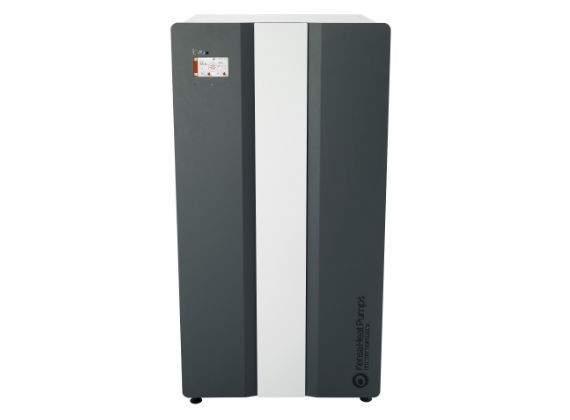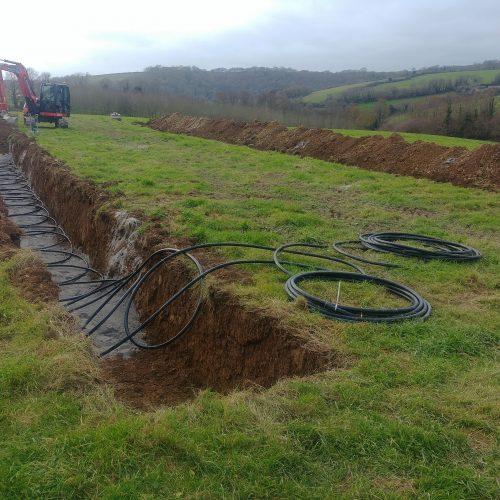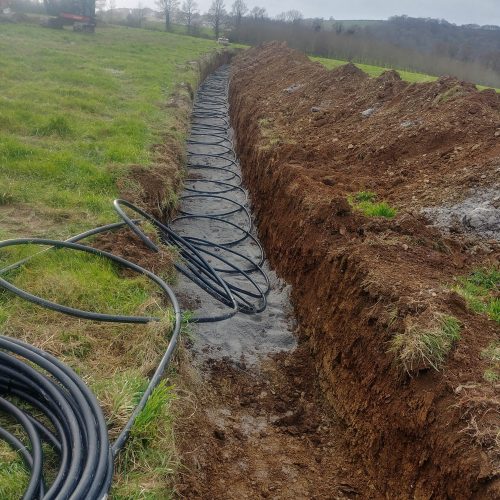RENEWABLE HEATING & ENERGY SPECIALISTS
HEAT PUMPS, SOLAR PV & BATTERY STORAGE SYSTEMS | DOMESTIC & COMMERCIAL
Ground Source Heat Pumps
A Ground source heat pumps or (GSHP) extracts solar energy stored passivly in the ground or water sources and converts this to a higher temperature for use within a building’s heating distribution system. A heat pump produces up to three times more energy than it consumes. So for every 1kWh of energy your heat pump uses to power itself, you will get typically 3kWh of energy to heat your property, As 1kW of electricity = 3kW of heat this means heating costs in most cases are effectively reduced by two thirds. This is known and the coefficient of performance (COP).
Due to their high efficiencies, CO2 emissions are significantly lower than traditional fossil fuelled systems (up to 43% lower than gas).

The Heat pump process
A cold water anti-freeze mix known as Glycol is pumped through the ground within a series of energy absorbing pipes, known as ground arrays or slinkies. As heat naturally flows from warmer to cooler places, the anti-freeze mix circulating around the array is constantly warmed by the ground’s low grade heat.
Having increased in temperature, the anti-freeze mixture is fed into a heat exchanger called the evaporator.
Within the secondary sealed side of the evaporator heat exchanger is a refrigerant which acts as a heat transfer fluid. When the water anti-freeze mixture enters the evaporator, the energy absorbed from the ground is transferred into the refrigerant which begins to boil and turn into a gas. The refrigerant never physically mixes with the water anti-freeze mixture. They are separated like sandwich layers by the plates of the heat exchanger which permit the heat transfer.
This gas is then fed into a compressor. The pressure of the refrigerant gas is increased in the compressor, which makes the gas temperature rise. The hot refrigerant gas then flows into a second heat exchanger, called the condenser, which features an identical set of heat transfer plates.
The condenser delivers water hot enough to serve the space heating system and, if required, the property’s hot water needs. Having transferred its heat, the refrigerant gas reverts to a liquid.
This liquid is then passed through an expansion valve at the end of the cycle to reduce its pressure and temperature, ready to commence the cycle all over again.

Southwest Renewables supply and install both domestic and commercial systems throughout Cornwall, Devon, Dorset and Somerset .
Heat pumps require very little maintenance, however since Ground source heat pumps produce a lower temperature heat than traditional boilers, it’s essential that your property is correctly sized and installed for the heating system to be effective. If possible, under floor heating can provide greater efficiencies than traditional radiators because the water doesn’t need to be heated to such a high temperature. If under floor heating isn’t possible, oversized radiators or a skirting heaters for example are both viable options
Our experienced team of renewable energy engineers will carry out an obligation free assessment to determine the most suitable system for your property and circumstance.


